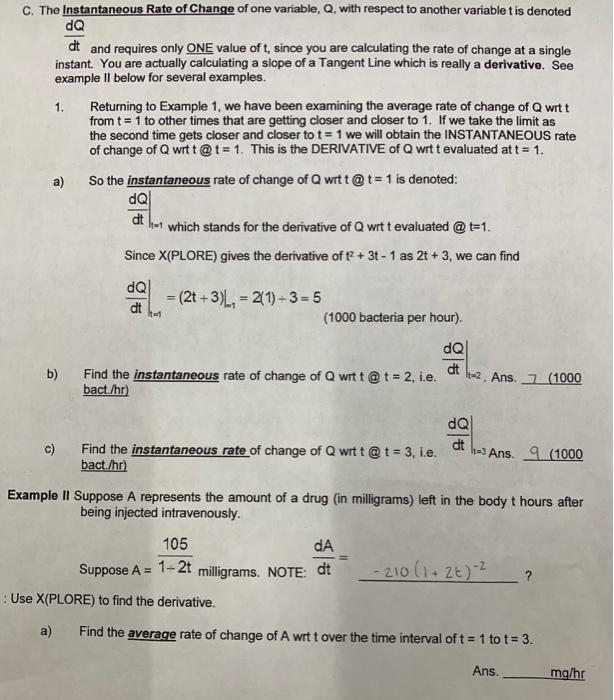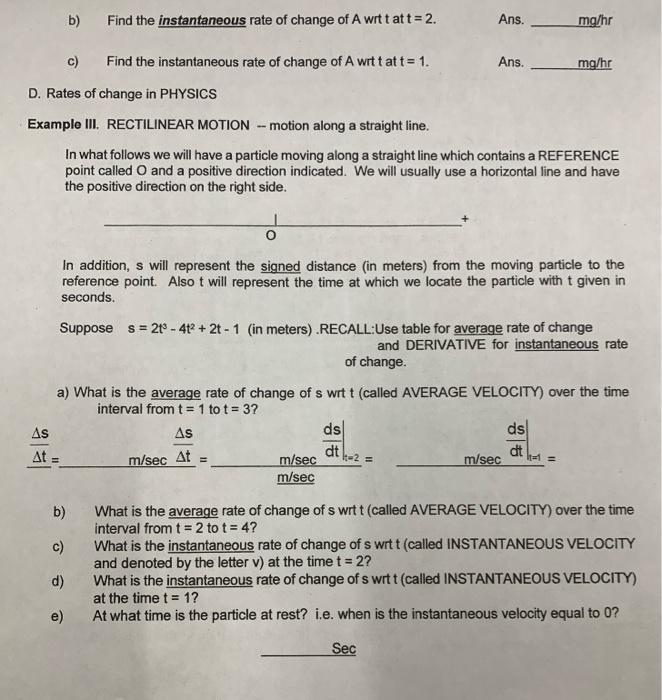Answered step by step
Verified Expert Solution
Question
1 Approved Answer
C. The Instantaneous Rate of Change of one variable, Q, with respect to another variable t is denoted dQ dt and requires only ONE


C. The Instantaneous Rate of Change of one variable, Q, with respect to another variable t is denoted dQ dt and requires only ONE value of t, since you are calculating the rate of change at a single instant. You are actually calculating a slope of a Tangent Line which is really a derivative. See example Il below for several examples. Returning to Example 1, we have been examining the average rate of change of Q wrt t from t = 1 to other times that are getting closer and closer to 1. If we take the limit as the second time gets closer and closer to t = 1 we will obtain the INSTANTANEOUS rate of change of Q wrt t @t=1. This is the DERIVATIVE of Q wrt t evaluated at t = 1. a) So the instantaneous rate of change of Q wrt t @ t = 1 is denoted: 1. C) dQ dt Itt which stands for the derivative of Q wrt t evaluated @t=1. Since X(PLORE) gives the derivative of t2 + 3t-1 as 2t + 3, we can find dQ dit a) = = (2t+3), = 2(1)+3=5 b) Find the instantaneous rate of change of Q wrt t @ t = 2, i.e. -2. Ans. 7 (1000 bact./hr) (1000 bacteria per hour). dQ dit Find the instantaneous rate of change of Q wrt t @ t = 3, i.e. bact./hr) 105 1-2t Example II Suppose A represents the amount of a drug (in milligrams) left in the body t hours after being injected intravenously. Suppose A = : Use X(PLORE) to find the derivative. dA milligrams. NOTE: dt dt 3 Ans. (1000 -210 (1+2t)- Find the average rate of change of A wrt t over the time interval of t = 1 to t = 3. Ans. mg/hr b) Find the instantaneous rate of change of A wrt t at t = 2. c) D. Rates of change in PHYSICS Example III. RECTILINEAR MOTION --motion along a straight line. In what follows we will have a particle moving along a straight line which contains a REFERENCE point called O and a positive direction indicated. We will usually use a horizontal line and have the positive direction on the right side. Find the instantaneous rate of change of A wrt t at t = 1. As At = b) c) d) e) In addition, s will represent the signed distance (in meters) from the moving particle to the reference point. Also t will represent the time at which we locate the particle with t given in seconds. Ans. Suppose s = 2t - 4t + 2t - 1 (in meters) .RECALL:Use table for average rate of change and DERIVATIVE for instantaneous rate of change. a) What is the average rate of change of s wrt t (called AVERAGE VELOCITY) over the time interval from t = 1 tot = 3? As m/sec At m/sec m/sec Ans. ds dt lt=2== mg/hr m/sec mg/hr ds dit 11=1 = What is the average rate of change of s wrt t (called AVERAGE VELOCITY) over the time interval from t = 2 tot = 4? What is the instantaneous rate of change of s wrt t (called INSTANTANEOUS VELOCITY and denoted by the letter v) at the time t = 2? What is the instantaneous rate of change of s wrt t (called INSTANTANEOUS VELOCITY) at the time t = 1? At what time is the particle at rest? i.e. when is the instantaneous velocity equal to 0? Sec
Step by Step Solution
★★★★★
3.58 Rating (148 Votes )
There are 3 Steps involved in it
Step: 1
C S Page no 1 The Change 11 Laj do at to 1 M ...
Get Instant Access to Expert-Tailored Solutions
See step-by-step solutions with expert insights and AI powered tools for academic success
Step: 2

Step: 3

Ace Your Homework with AI
Get the answers you need in no time with our AI-driven, step-by-step assistance
Get Started


